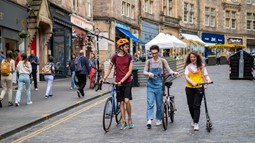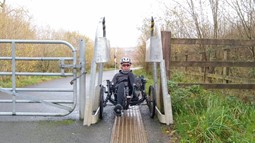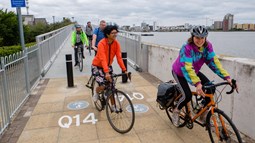Sales and use of e-scooters (or electric-scooters) are rapidly increasing in the UK. Sustrans will continue to prioritise active or partially active modes of travel, such as walking, wheeling and cycling, over e-scooters. However, Sustrans believes e-scooters can play a positive role in increasing transport choice while reducing pollution and congestion in our cities.

This Sustrans policy position is comprised of two parts:
- Part 1: Sustrans e-scooters policy position
- Part 2: Sustrans policy position for e-scooters on the National Cycle Network.
Sustrans policy position on e-scooters
Summary
- Sales and use of e-scooters (or electric-scooters) are rapidly increasing in the UK.
- Sustrans will continue to prioritise active or partially active modes, such as walking, wheeling and cycling over e-scooters. However, Sustrans believes e-scooters can play a positive role in increasing transport choice while reducing pollution and congestion in our cities.
- We support the need to legalise e-scooters. Legislation needs to ensure their use is safe and inclusive. In addition, local transport authorities need financial support to ensure rental schemes better integrate with public transport to ensure more e-scooter trips replace journeys previously taken by car. More also needs to be done to reduce conflicts with other modes, especially the impact of parking on the footway.
Context
E-scooters are similar to kick scooters but powered by an electric motor and battery. They are classified under Department for Transport guidance as ‘powered transporters’.
The sale of powered transporters is legal, however using a privately owned powered transporter, such as an e-scooter on public land, including on roads, cycle paths, and pavements, is illegal and can lead to prosecution.
Despite this legal position, sales have been rapidly increasing in the UK and they are becoming more common on roads, pavements and cycling infrastructure, especially in cities.
In July 2020, the UK Government launched e-scooter trials, which legalised approved e-scooter rental schemes. As part of the conditions, e-scooters must meet certain technical requirements and users must have a provisional or full UK driving license to rent an e-scooter.
Accordingly, it is legal for rental e-scooter users within trial areas to use an approved rented e-scooter on a public road and anywhere else that cycles are permitted to use.
The UK Government is considering legalisation more widely, as part of the DfT Future of Mobility: Urban Strategy, including privately owned e-scooters to be used in the same way as approved rental e-scooters.
What we think
E-scooters can increase transport choice and help address air pollution and congestion.
Sustrans believes e-scooters have the potential to provide a useful addition to transport choice and could help reduce congestion and improve air quality in urban areas when they replace journeys by car.
Our own research, for example, found young people (16–24-year-olds) face greater transport barriers than other adult age groups as result of lower spending power and reduced car ownership. E-scooters are frequently used by young people and can support greater access to education, jobs, and opportunities.
For everyone’s safety, we need e-scooter legislation and guidance
Sustrans supports the need to legalise e-scooters and believes the UK government should prioritise passing legislation to ensure e-scooter use is safe, including battery charging. We support safety regulations which should include, at a minimum, speed limits, minimum wheel sizes, parking regulations, and avoid their use on footways.
Steps should be taken to stop retailers from selling e-scooters that do not comply with the above requirements, including battery sales. We welcome new guidance from the Government on battery safety although believe more action to be done in this area.
The Government should also consider fitting anti-tampering devices to stop users increasing speeds. All e-scooters should be fitted with independent front and rear brakes, lights, indicators, and an audible warning device.
It would also be useful to clarify where e-scooters sit in the Highway Code is essential including the established hierarchy of road users, as is the need to increase decision-making based on this hierarchy.
Safety and use on pavements and the carriageway
It is Sustrans’ view that e-scooters can present a safety risk to people walking and wheeling, in particular disabled people, older people and children sharing the pavement.
This means e-scooters should be permitted only where it is permitted to cycle. E-scooters should only be permitted on pavements where they are a shared use path that already permits cycles. In high footfall areas these should be reviewed with protected provision on the carriageway created wherever possible, typically through a cycle path.
Dockless rental e-scooter schemes can impede pedestrians when e-scooters are left on the footway. These issues can be exacerbated by multiple scheme providers in the same city competing for ridership.
Operators and local transport authorities need to work together to solve parking issues through the creation of designated parking bays in areas that do not create access problems, and in particular moving parking off the footway and onto kerbside space within the carriageway.
Just like cycling, there are dangers in sharing road space with other motor vehicles. Sustrans believes if cycling and scooting are to become normal, everyday forms of transport, we must improve infrastructure and separate motor vehicles from people travelling by other modes wherever necessary.
Modal shift and active travel
Physical inactivity costs the NHS around £900 million per year, and wider society £7.4 billion. Increasing the number of active trips has the potential to prevent and manage over 20 chronic health conditions by building physical activity into daily activity. This is why Sustrans prioritises active modes.
Some studies (Department for Transport, Research Office, Nature Energy journal), mainly of rental schemes, have indicated that e-scooter trips are most likely to replace journeys that would otherwise have been taken by an active mode.
More needs to be done to design rental schemes that reduce car use, including better integrating e-scooters with public transport, and improving provision serve areas with limited existing public transport options. This should ensure they are more attractive as alternatives to car use.
Inclusivity
The evaluation of the e-scooter trials in the UK found that many users were aged between 16 and 34 and predominantly male. People from ethnic minority groups and on a low income were more likely to report being regular users. This suggests some positive benefits of e-scooters for people more likely to be disadvantaged. As rental schemes are currently run for profit without public subsidies, they may not reduce transport inequality in cities.
We believe greater control of rental schemes, for example through licensing, local government regulation and partnership should be explored to understand how schemes can contribute towards greater public benefit. This would also benefit the economic sustainability of schemes.
E-scooters can compete with local public transport. This may impact the viability of routes and pricing, having a disproportionately negative impact on people of lower socio-economic status who rely most on public transport. For this reason it is increasingly important that e-scooters be considered with and potentially in the future as part of public transport provision.
The E-scooter trials specify that riders must have at least a provisional driving license in order to use e-scooters. Steps should be taken to understand if this is a barrier from usage where people do not drive to ensure e-scooters are accessible to the widest number of people, whilst still ensuring that children are not permitted to use them.
Sustrans Policy position for e-scooters on the National Cycle Network
As custodian of the National Cycle Network, Sustrans notes that some of the Network’s off-road surfaces are not suitable for the very small wheels typical of some e-scooters, which have been identified as a significant risk factor. Users of e-scooters may also present a risk to other paths users, especially on busy sections.
Off-road National Cycle Network that is owned or managed by Sustrans
Sustrans’ position is that no e-scooters are currently permitted on off-road National Cycle Network that Sustrans owns or manages without express permission on a case-by-case basis. This applies to both privately-owned and hired e-scooters.
We will keep this position under review and respond to any consultation by local or national governments, as appropriate.
Off-road National Cycle Network that is not owned or managed by Sustrans
The use of e-scooters on off-road National Cycle Network that is not owned or managed by Sustrans is at the discretion of individual landowners, although we would welcome being consulted. An example is where the Network crosses a local authority park, or a landed estate.
In areas with an e-scooter trial, the local Highways Authority will need to obtain the agreement of any relevant landowner or occupier, as use will be at their discretion including land which is part of the National Cycle Network.
We will consider working with individual landowners to permit use and/or install permissive or prohibitive signage on a case-by-case basis where it is considered necessary and proportionate.
On-road National Cycle Network
The majority of the National Cycle Network is on the public highway.
E-scooters are currently classed as motor vehicles in the UK. This means that their use is effectively illegal on-road, except where e-scooter hire trials are taking place.
Each Highways Authority conducting e-scooter trials will need to clarify whether rented e-scooters are permitted on cycle lanes, bridleways and other infrastructure, not including pavements, that are part of the local adopted highway.





